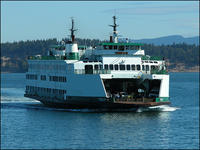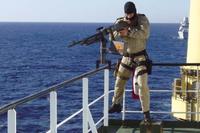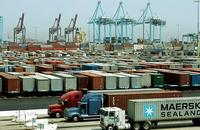-
Bomb sniffing dogs deployed to Long Island ferry
A New York ferry company has become the first in the United States to receive federal grants to pay for the deployment of explosive detection canine teams; the Bridgeport & Port Jefferson Steamboat Company is teaming up with Long Island K-9 service to use bomb sniffing dogs to detect any explosives aboard the ferries; the canine teams will inspect every car that enters the ferry; teams were initially deployed on 13 May and the contract will last for three years
-
-
CBP Announces New Small Vessel Reporting System

U.S. Customs and Border Protection the other day announced the availability of the Small Vessel Reporting System along the northern border and in Florida, Puerto Rico, and the U.S. Virgin Islands; the system is voluntary, and — as is the case with the air travel’s Trusted Traveler program — it aims to provides expedited entry procedures to trusted boaters; the system is open to all U.S. citizens and permanent residents, as well as Canadian citizens
-
-
"See Something, Say Something" campaign hits Seattle ferry system

Last week, a senior DHS official examined security measures at the nation’s largest ferry system; Betsy Markey, DHS’s assistant secretary of intergovernmental affairs, rode aboard a ferry last Thursday in Seattle as it sailed from Colman Dock to Bainbridge Island; Markey’s visit comes as a part of a broader DHS push to promote its “If You See Something, Say Something” public awareness campaign; the campaign will be implemented in conjunction with the Washington State Ferries (WSF) system; WSF is the largest and most complex ferry system in the United States with its twenty terminals and nine routes
-
-
Ships increasingly turning to armed guards to combat piracy

To stem the rapidly growing number of pirate attacks in the Indian Ocean, more shipping companies are turning to armed guards; last year attacks off the Somali coast hit an all-time high with forty-nine ships hijacked along with 1,016 crew members; to combat the growing threat of piracy an estimated 20 percent of ships operating in the Indian Ocean and the Gulf of Aden will hire armed guards within the next eighteen months, up from 12 percent; analysts say no ships have been successfully hijacked when armed guards were present
-
-
New anti-piracy tool: 1,000-participant Internet wargame

The U.S. Navy is recruiting a community of more than 1,000 players from across the U.S. government to collaborate on solving real-world problems facing the U.S. Navy: high-seas piracy; the participants will be asked to suggest ways to combating piracy off the coast of Somalia
-
-
British insurance firm building its own anti-pirate armada
With pirate attacks hitting all-time highs, a British insurance firm is creating its own fleet of gunships to help prevent these costly disruptions; in the first quarter of 2011 pirate attacks reached record highs with 142 incidents occurring; to combat this growing threat, Jardine Lloyd Thompson, which insures roughly 15 percent of the world’s maritime cargo ships, is launching its Convoy Escort Program (CEP), which consists of a fleet of eighteen gunboats; so far no country has agreed to allow the private firm to carry out its plans and it lacks the ability to operate legally; the firm has already raised all the funds necessary and could be ready to begin escorting ships as early as this year
-
-
Anti high-seas piracy coalition launches public campaign
“2,000 Somali pirates are hijacking the world’s economy” — this is the motto of a new coalition of maritime transportation organization which has launched a public campaign to encourage governments to take more active measures to tackle high-seas piracy; the Save Our Seafarers campaign has a Web site and will take out ads in leading world newspapers
-
-
Authors suggest ways to alleviate L.A. cargo port "constipation"

In January, the port of Los Angeles received more than 330,000 containers; the possibility that one of those 330,000 containers could have contained a dirty bomb, or worse, keeps security experts up at night; experts say that to ensure security and prevent logjams, the best approach to container security would be to replace the current system, which singles out only those containers whose documentation raises questions, with a system which will see terminal operators X-ray every container, regardless of its eventual destination; only those containers flagged during the low-level scan would be subjected to a more thorough search
-
-
NYPD's combat vessel will thwart Mumbai-like attacks
To prevent a Mumbai-like attack in New York, the NYPD will be getting a high-speed combat vessel; the 71-foot craft, which can hit speeds of 40 knots and will be able to carry up to thirty police officers fully armed with heavy weapons; the high-speed boat will be outfitted with radiation detection equipment and infrared cameras, as well as a satellite communication facilities
-
-
New radar improves pirate threat detection
New maritime radar helps protects ships again pirates; the radar is effective in detecting small targets, especially in high levels of rain and sea clutter, and it automatically alerts watch keepers about craft displaying hostile behavior patterns
-
-
Securing America's ports
Each year roughly $3 trillion worth of goods enters into the United States via water and more than 90 percent of the world’s cargo travels by sea making ports a prime target for terrorist organizations; it was not until the after 9/11 that port security became a top priority; the Port of Long Beach handles 40 to 45 percent of all the goods that enter the United States; to secure the 3,200 acre Port of Long Beach, the port has added a sophisticated series of security measures in recent years; a senior official from the Port of Long Beach will be speaking at a panel at the upcoming ISC West Conference to discuss port security strategy and interagency coordination
-
-
New association for maritime security industry formed
Maritime security consultant Peter Cook recently announced the formation of the Security Association for the Maritime Industry (SAMI); SAMI will help establish rules and regulations in the fledgling maritime security industry; the maritime security industry has grown rapidly in recent years, but has suffered from lack of regulation and rapid expansion; the industry’s reputation has been tarnished with incidents of hired security firms abandoning ships when pirates attack leading to long periods of captivity for the ship’s crew; to prevent these incidents from occurring and to uphold the reputation of the industry, SAMI will vet maritime security companies, establish standards, and ensure that its members comply with established standards
-
-
Coast Guard works to prevent rising mission-related deaths
Admiral Robert Papp, the commandant of the U.S. Coast Guard (USCG), announced that the service is conducting a comprehensive review and may eliminate certain missions and capabilities, in light of the sharp increase of mission related deaths; in the past two years, fourteen Coast Guard aviators and one Maritime Safety and Security Team (MSST) member have died in accidents that occurred during routine missions; Admiral Papp is concerned that service members are overburdened by training for too many different skill sets and have had inadequate time to master them; since 9/11 USCG has added missions and capabilities without a corresponding increase in service personnel; Papp cites a helicopter crash in July 2010 that killed three aviators as evidence; the crash occurred during a routine mission in which the team was flying from Astoria, Oregon to Sitka, Alaska
-
-
Mobile biometric screening technology for seaports years away
A recent report by the Government Accountability Office (GAO) found that U.S. Customs and Border Protection (CBP) is still years away from implementing handheld biometric screening devices electronically to verify passengers entering the United States aboard ships; approximately five million people arrive in the United States by sea each year; CBP agents currently conduct inspections aboard ships and lack access to databases to verify passports, travel documents, or passenger information and report their findings which has led to incorrect and untimely updates to national databases; DHS has made procurement of these devices a “high priority,” but believes it will be years before they can be implemented aboard ships; the primary challenge is remotely linking the mobile devices to databases in the maritime environment
-
-
Pirate attack prediction model developed
A mathematician has developed a piracy prediction model based on wind, waves, currents, as well as on the ground intelligence that could help predict the probability of a pirate attack on a given day; the system would function like a tornado warning system using weather data to project high risk areas on a map; the map could be further refined by adding in real time shipping traffic to indicate which ships are most likely to be attacked; piracy has grown worse in the last year, despite stepped up naval patrols; 80 percent of the world’s cargo still travels by sea
-
- All
- Regional
- Water
- Biometrics
- Borders/Immig
- Business
- Cybersecurity
- Detection
- Disasters
- Government
- Infrastructure
- International
- Public health
- Public Safety
- Communication interoperabillity
- Emergency services
- Emergency medical services
- Fire
- First response
- IEDs
- Law Enforcement
- Law Enforcement Technology
- Military technology
- Nonlethal weapons
- Nuclear weapons
- Personal protection equipment
- Police
- Notification /alert systems
- Situational awareness
- Weapons systems
- Sci-Tech
- Sector Reports
- Surveillance
- Transportation
Advertising & Marketing: advertise@newswirepubs.com
Editorial: editor@newswirepubs.com
General: info@newswirepubs.com
2010-2011 © News Wire Publications, LLC News Wire Publications, LLC
220 Old Country Road | Suite 200 | Mineola | New York | 11501
Permissions and Policies
Editorial: editor@newswirepubs.com
General: info@newswirepubs.com
2010-2011 © News Wire Publications, LLC News Wire Publications, LLC
220 Old Country Road | Suite 200 | Mineola | New York | 11501
Permissions and Policies
